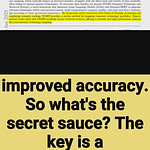Ensemble of neural decoders with LLM arbitrator cracks the brain-to-text code
Brain-to-text decoding competition reveals ensemble methods with LLMs significantly improve speech decoding accuracy from neural signals, reducing word error rates from 9.7% to 5.8%.
-----
https://arxiv.org/abs/2412.17227v1
Original Problem 🎯:
Converting brain signals to text for paralyzed individuals faces accuracy challenges, limiting natural conversation capabilities. Current decoders make frequent errors, especially with key content words.
-----
Solution in this Paper 🔬:
→ Teams used ensemble decoding where multiple independent neural decoders generate diverse predictions
→ A fine-tuned LLM then merges these predictions to select the most accurate transcription
→ The winning team (DConD-LIFT) introduced diphone-based decoding that considers transitions between phonemes
→ Training optimizations included step-wise learning rate decay, layer normalization, and coordinated dropout
→ Model ensembling combined with LLM rescoring proved more effective than architectural improvements
-----
Key Insights 💡:
→ RNNs outperformed transformers and deep state space models, suggesting they're better suited for neural decoding
→ Small dataset size (10,000 sentences) limits effectiveness of modern architectures
→ Two-stage approach (separate neural decoding and language modeling) creates performance inconsistencies
-----
Results 📊:
→ Baseline RNN: 9.7% word error rate
→ DConD-LIFT (winner): 5.8% word error rate
→ Phoneme error rate improved from 16.62% to 15.34%
------
Are you into AI and LLMs❓ Join my daily AI newsletter. I will send you 7 emails a week analyzing the highest signal AI developments. ↓↓
🎉 https://rohanpaul.substack.com/










